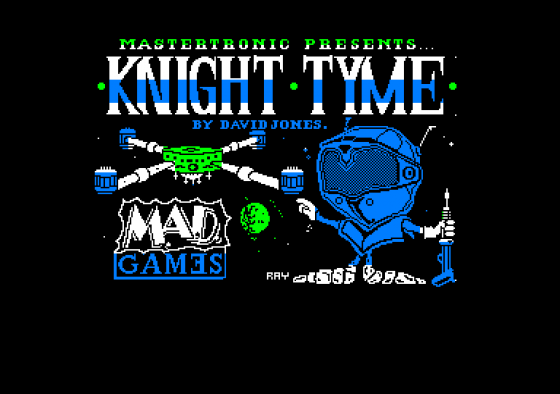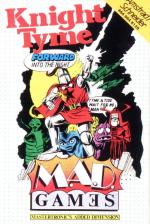
Amstrad Action
 1st August 1986
1st August 1986
Categories: Review: Software
Author: Bob Wade
Publisher: Mastertronic Added Dimension
Machine: Amstrad CPC464
Published in Amstrad Action #11
Mastergame
Knight-Tyme
Mastertronic's Magic Knight has appeared in two previous games, Finders Keepers and Spellbound, but Knight Tyme is his crowning glory as he tries to get back to the past from a starship in the 25th century. It features the 'windimation' system from Spellbound, but is even more packed with characters, objects, locations and things to do.
Magic Knight's task is to find a "Tyme" machine that will take him back to his medieval existence - after all, life in the 25th century isn't easy for a guy in a little tin suit. He appears in a transporter room on board the USS Pisces. His first task to explore the ship and familiarise himself with the characters and objects in it.
The three most important rooms in the ship are the bridge, transporter room and transputer room. The "transputer" is the ship's computer and, at the start of the game, it provides a lot of helpful information to get you going. The bridge is where the starship is controlled from, but to do that you'll need the authority and knowledge to get it moving. The transporter enables you to beam down to the planets that the star ship orbits, but again you'll need to get it working first.

The Magic Knight moves left and right on screens and can jump onto things, but the main control is via the 'windimation' system. This is a series of window menus that present a number of commands and options, depending on the location, objects carried and characters present. There's a single main menu that has familiar commands on it for object manipulation: pick up, drop, take and give (from or to another character), examine, wear and unwear(?).
There are other options that need not always appear and these have many different uses. You can command characters, read things, blow things, cast spells, communicate and move the ship. The further you get, the more commands you'll find and each one will have one or more submenus. For instance, if you want to command a character you first have to find who you want to command, then tell them what you want them to do and then watch the response and action that takes place.
Using the system to its fullest will take some time but the general rule is to try doing everything to anything to start with. Performing tasks and solving problems is usually a case of following up on a clue given somewhere or making a logical deduction about what to do with things.

The other characters in the game are very important and they come in several shapes and sizes. There are droids and computers, humans and aliens, all of whom may carry useful objects or be able to perform tasks for you. Dealing with them isn't always easy because they may not be in a good mood, or even able to help. As in Spellbound, you will have to look after characters' welfare in order to make them cooperative, but you'll have to watch out for your own as well.
Throughout the game there are marvellous touches of detail and humour that reflect the hard work and personality put into it by David Jones the programmer. You'll come across all sorts of smart remarks and great features, like the view from the bridge of the ship as it moves between planets. One example of the detail and humour is when the Magic Knight wears a gas mask - if he then tries commanding the other characters all they hear is "a muffled voice" and then go about their business.
There are a massive number of problems to crack and things to do. You'll spend the first few hours just working out everything in the starship, never mind exploring the many planets.

Knight-Tyme's graphics are the only disappointing part of the game, because they lack colour. The soundtrack plays throughout and is very pleasant. But what really bowls you over is the humour, detail, puzzles, difficulty and size that, at a delightful £2.99, blow most full price games out of sight. Budget games of this high quality should shame many full price software houses into getting their act together.
Good News
P. 'Windimation' system is a joy to use.
P. Great sense of humour.
P. Lots of intriguing and difficult puzzles.
P. Interaction with other characters to help and hinder.
P. Great features like space flight and teleporter.
P. Good accompanying music.
P. All this for £3 - a remarkable bargain.
Bad News
N. Graphics, screen size and use of colour aren't all they could be on an Amstrad.
Second Opinion
This game is just superb. If you want the wit and puzzling of Hitchhikers coupled with cute animation and great music, it delivers - and with change from a measly £3! How Mastertronic manage this kind of quality this cheap, I really don't know. Buy it, play it, marvel at it - it's terrific.
Green Screen View
It plays fine and looks okay too, so you've got absolutely no excuse. Buy it.
Budget Bonanza
This month sees a special event for Amstrad Action - our first ever budget Mastergame. It's not just a good budget game but one of the best arcade adventures ever.
The increasing quality of budget games puts increasing pressure on software houses to either drop their prices or reach higher standards. The big names can't get away much longer with producing inferior (if not downright appalling ripoff) products like World Cup Carnival without alienating their public.
This almost certainly isn't the last budget game that will get Mastergame status because more and more software houses are entering the budget market. The existing ones also are continuing to improve their games quality. That can only be good news for games-players, whose wallet and computer will both benefit from the experience.
Other Reviews Of Knight Tyme For The Amstrad CPC464
Knight Tyme (Mastertronic Added Dimension)
A review
Knight Tyme (Mastertronic)
A review
Scores
Amstrad CPC464 Version| Graphics | 63% |
| Sonics | 69% |
| Grab Factor | 91% |
| Staying Power | 94% |
| Overall | 95% |













